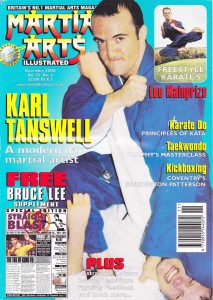Taekwondo Sparring for Beginners
MARTIAL ARTS ILLUSTRATED MAGAZINE, November 2000, Vol.13, No.6, p.47 – 49.
If you read this article…
You will help the martial arts industry to grow by helping newcomers, ease into the contact side of martial arts. If they have trained regularly and just about to purchase the sparring equipment, you really want to avoid them dropping out. This article could also be called Sparring too much too soon, one of the main reasons for a high rate of student drop out.
INSTANT GRATIFICATION
What is the difference between other contact sports and the martial arts? Or should we rephrase the question to… If martial arts are so beneficial and full of value, why do so many choose football or basketball over martial arts?
They are, apart from the obvious fundamental differences a number of “instant gratification” advantages for the newcomer to football compared to the newcomer to martial arts.
Did you ever stop to watch a group of kids kick a football around in your local park or shoot a few baskets? Not one looks out of place. Although they are aware that others may be watching they continue to play, regardless of whether or not they make the odd mistake. No one “expects” them to be a Pele or a Michael Jordan so they quickly fit in. They “feel” the sensation of kicking the ball the instant they begin regardless of their level of fitness. Culturally and socially the activity is not only accepted but also actively encouraged. And who cares if their timing, accuracy, coordination, balance and positioning, are not up to par, they enjoy themselves and have a good time.
Although football is termed a contact sport, there is no urgency to stand and square off eye to eye with the opposition; this takes away any burden on the novice of football. For the beginner martial artist who has just invested in sparring gear, this psychological arena one of the first things that is to be overcome.
Compare the football novice to the new beginner martial artist and immediately we see a number of distinct physical, psychological and even social differences.
For a start there is no instant gratification available for the novice martial artist. Most new students are introduced into the martial arts by the age-old tradition of referral, which is the best way to show your appreciation to your instructor and your school. These new beginners must and should be hand held for the first few crucial months to maintain longevity.
There are a number of rituals, mostly oriental, that they must adhere to, from tying the belt to understanding the class structure and commands used.
All this is so difficult compared kicking a ball, or feeling that instant gratification when you shoot a successful basket. Beginners to Taekwondo sparring cannot workout alone so are dependent on a partner or a coach. It will be a while before they look and feel part of the group. They are mostly lacking in confidence and even with the simplest of partner work turning to face someone may not be a favorite part of their lesson.
Encouragement may not be high on the agenda list of their peers or even their instructors who may have forgotten what it is like to be a beginner, making mistakes, looking and feeling embarrassed will play on their frail confidence. Socially they may have to contend with jibes from their friends and even family, enduring the standard wind ups like “Hiiyyaaa” or “Watch out here comes Jean Claude Van Damme” and “Hello Bruce”
Confused expectations and preconceived ideas may intimidate the beginner, however nothing is more intimidating than sparring. It is the one of the main causes of student drop out.
The word sparring has scared off many novices. Preconceived ideas on what exactly is expected when the sparring becomes an issue.
There is a sense of urgency too in getting to wear the sparring gear too soon and sparring too much to soon. Perhaps in a rush to get to the coveted Black Belt. Three to four years is ample time to get to a good standard of Black Belt.The following two lists show physical and mental characteristics needed for sparring
Physical characteristics
Good Health
Strength/Flexibility
Endurance/Stamina
Learning/understanding distance
Controlling level of contact
Basic distance and timing
Mental characteristics
Proper focused learning attitude
Safe training conditions
Trusting partners/coach
Positive encouraging environment
Habitual conditioned regular training
Even balance of discipline and enjoyment
Every novice to sparring must be carefully educated on the to facilitate a progression to safe and enjoyable sparring. Sparring guidelines and a clear set of rules must be clearly communicated to sparring students. How do you do this? By hand in the shape of guideline booklet/leaflet, or your school newsletter. Perhaps implement the knowledge of the sparring rules as part of the grading system. Constantly give verbal reminders of the rules and use any visual method such as poster or a large notice if possible. The best way to educate folk is by example. Remember “Clear well communicated expectations are the key”.
That is why verbal and visual communication must be clear to all students who wish to partake in sparring.
SPARRING RULES
The following rules and guidelines are posted in my own school. Please feel free to use them if they make your sparring more enjoyable.
- Headguards, Handpads, Footpads, Gumshield & Groin guard must be worn.
- Always inform your instructor of any injuries you may have.
- Sparring is forbidden unless a qualified instructor is present.
- Sparring equipment is for touch contact only – it is not a license to use full force.
- Exercise extra control if you weigh more than your opponent.
- You should have at least six months training experience before you are allowed to spar unless otherwise stated by your instructor.
- Inform your opponent politely if they are using excess force. If this fails, inform your instructor.
- Yellow cards may be given out for excessive contact and an accumulation will result with missing sparring involvement.
Always bare in mind that there may be a student who may have had to deal with an unpleasant situation at some stage in their life, and that was why they came for martial arts training in the first place. Facing someone in a martial arts class for sparring may cause some flashbacks to this negative experience. Confidence needs careful nurturing here. Even the ritual of putting on the sparring gear can be upsetting for an individual who is passive by nature. From a male standpoint, we are taught from the cradle to be strong brave gutsy and that fighting is part of growing up for boys. Men in particular, I can tell you, may not admit that these hidden fears are a cause for concern. So what happens? they simply quit, blaming it on their work or any other reason, other than that they were forced into a sparring too soon into their learning curve.
To recap on this article
Try to get your students in a reasonable fit state first before they even begin sparring. Teach by the principle of progression by ensuring the students learn the basic distances for hands and then legs using sparring drills. Such drills could be incorporated into your curriculum. Encourage openness and with your students and a comfortable atmosphere so that there is no shame in admitting that you’re afraid sometimes when faced with an opponent. Sharing fear is better than keeping it locked up and in this way the fear can be overcome. Put safety first and not only will you avoid injury but you will also have fun during your sparring.”
For the images of the original article, click on the picture of the front cover of the magazine and scroll down.
Article by Frank and Catarina Murphy





